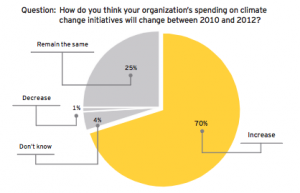‘Magnetic marketing’ is both fact- and psyche-based. Instead of being based on the combination of hard facts on the one hand, and true insights into customer behavior on the other, marketing and marketing communications too often are based on assumptions. How to best leverage psychology in B2B marketing?
Social media play a pivotal role in B2B, even more so than in B2C. This is the key conclusion from the GlobalWebIndex Research involving interviews with 17,425 decision makers in 27 markets from July 2009 to June 2011 (this, by the way, makes one wonder why the results seem to have only been published this Fall).
Four clear trends were identified:
#1. B2B decision makers are the most socially engaged in the world: B2B decision makers are the most socially active consumers for all markets and demographics.
#2. B2B decision-makers stand out most in developed markets. In developing markets such as China they are still more active than the norm but the gap is significantly smaller.
#3. Social media communications has the most influential channel for business purchases globally, out ranking even face-to-face meetings, conferences, client entertaining or traditional trade advertising in most markets.
#4. B2B decision-makers are increasing their usage of social media: Despite an already high level of usage between July 2009 and July 2011, for example, social network usage increased from 41% to 60%, while micro-blogging grew from 21% to 39%.
These insights show social business opportunities are to be taken seriously in B2B. As the trust and people factors in B2B are even greater here, these findings should confirm what most of you already were expecting. However, a bit more background on the (set-up of this) survey would make these findings even more compelling. And could take away doubts people still have on social business in B2B – as phrased in the questions below.
> Couldn’t the results demonstrate that B2B senior people spend a greater proportion online each 24 hours than the ‘average person online’?
> Is the usage of social networks by B2B decision makers (as assessed in this survey) always related to making a business decision?
> Or could their social media time be explained as a way to pleasantly pass the time – waiting for their airplane or train – uploading pics to Flickr or reading their cousin’s funny tweets or posts on Facebook?
Your thoughts/ suggestions are – as always – highly appreciated.
Results of a study amongst 132 B2B marketers jointly conducted by Booz & Co, American Business Media (ABA) and the Association of National Advertisers (ANA) was presented last week. Assuming the findings are (or will soon be) relevant for the European and Dutch marketplace as well, this survey made me wonder.
In the midst of the perhaps biggest environmental catastrophe ever – the oil spill in the Mexican Gulf – sustainability demonstrably rising on the executive agenda provides some inspiration. Even in this economic downturn companies now see the business benefit of ‘going green’ both in terms of bottom line cost reduction opportunities and top line growth. Has the green revolution now really reached the executive boardroom?
A survey (‘Action amidst Uncertainty’) released by Ernst & Young last week indicated CXOs are now serious about riding the green wave. Some 70% of all CXOs participating – three hundred global corporate executives from 16 countries with at least US$1b in annual revenue – indicated to significantly increase spending relating climate spending.
The key 5 take-aways for me from this E&Y survey:
1) Whilst sustainability is getting senior management attention, only in 30% of cases is the role accountable for making sustainability work a full time job. In two third of all companies, the ‘CGO’ (Senior Green Officer) does not report to the CEO (yet).
2) Whilst the western world still predominantly seems to react to the green wave – spurred into action by changing legislation – Asian companies take a far more proactive attitude – thinking (& acting upon) green innovation and sustainable products.
3) The lack of global standards and regulations does not slow climate change investments. Other market drivers, such as equity analysts’ growing interest in climate change performance, equally drives the market to go green. The lack in global standards does not hamper the audit industry either; the majority of surveyed companies (62%) do prefer to have their sustainable progress benchmarked by an independent 3rd party.
4) Two so-called ‘HR-issues’, the lack of required skills and lack of awareness, both would call for a more ‘open’ attitude to solving the green jigsaw puzzle, for instance by adopting social innovation and Enterprise 2.0 strategies in an effort to better assess real needs and wants in the marketplace as well as to build a platform for online co-creation and recruitment. Both inside and outside the enterprise.
5) Whilst 2/3 of companies are involved in active dialogue with suppliers on the sustainability issue, only 1 in 3 companies actively collaborate with their suppliers in order to make tangible green progress. The survey does not mention active involvement with customers surprisingly enough (was it included in the questionaire at all?!). Especially in B2B environments one would expect customer advisory or innovation board to touch upon the green theme.
When are companies like BP finally going to realize that the disciplines of Social | Green | Business are inextricably and increasingly linked? As the E&Y rightly summarizes “Integration is essential for successful execution.“
Recently I had the opportunity to attend the Great Place to Work event in Amsterdam. This platform brought together nominees for the GPtW award, i.e. the best employers in the land. My 5 key take-aways from the session, in random order:
- In the category medium-sized companies there was only 1 public organisation, i.e. the RGS Enkhuizen (a secondary school) nominated (congrats btw). Having spoken to its dean, it became clear how much room for mutual learning there still is. Too many schools isolate in splendid isolation and show to learn little from more advanced peers in the nation (or abroad).
- In general, there is a 20%+ gap between GPtW nominees and ‘the rest’ of the pack. Dutch employers on average score a meagre 58%, whilst top GPtW companies score almost 80%. Roooom for improvement therefore.
- The value of employees’ personal vision statements as input to build a more sustainable joint company roadmap and vision. Personal vision statements can also help better (re)connect employees which benefits work satisfaction, employee retention and generally a better flow of ideas. Just to name a few. A personal vision is all about knowing who you are, what you want (short & longterm) and what you’re best capable of. Aspects that seem so obvious, that most of us professionals or companies spend little time exploring, formalising or reshaping. Yet when shaped together, a personal vision becomes a very powerful perspective as Ilse Nelemans and Salem Samhoud describe in their book on this topic: “You Are Who You Will Be”.
- Almost all of the nominated companies operate in the business of consulting, professional services and IT. Is there a relationship between verticals and score or has GPtW simply not been marketed as enthusiastically in eg manufacturing?
- Authenticity counts. A number of videos of best places to work were shown to the crowd. Whilst all companies video-taped stressed the need for authenticity, personal touch and so on, only 1 company (NetApp) came with a video from the heart: not scripted and without auto-cue.
GPtW nominees perhaps have better managed to redefine the meaning of work to their employees, customers, partners and themselves. What’s your definition of Work 2.0?



